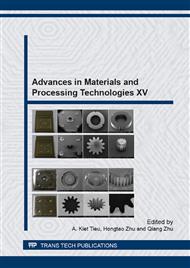p.218
p.226
p.234
p.242
p.250
p.257
p.263
p.268
p.275
Investigation on Failure Limit of the Perforated Sheet for Truss PCMs in Multiple Pin Stretch Forming
Abstract:
Periodic cellular metals (PCMs) based on lattice truss structure have been developed for a wide range of potential applications with their lightweight and multi-functionality. Although divers methods to fabricate truss PCMs, such as investment casting, perforation-bending, and extrusion-EDM, have been reported, the processes have been limited to fabricate flat plates. The paper proposes a new method, multiple pin stretch forming, to fabricate the truss PCM with various cross-sectional shapes. The process has some advantages to fabricate the truss architecture with locally different height and reduce the waste of material during perforation process compared with conventional processes. However, since a 3-D truss structure is built up by tensile deformation of truss members in the process, it is important to design the geometry of precursor sheet to avoid unexpected fracture and make full use of elongation of a given material. The paper focused on the design of precursor sheet through the investigation on failure limit in multiple pin stretch forming. The forming failure were predicted by FE simulations combined with a ductile fracture criterion for various geometrical conditions, and a forming failure diagram was constructed and verified with experiments. And finally, pyramidal truss PCMs with flat and stepped cross section were fabricated successfully without any defects.
Info:
Periodical:
Pages:
250-256
Citation:
Online since:
November 2013
Authors:
Keywords:
Price:
Сopyright:
© 2014 Trans Tech Publications Ltd. All Rights Reserved
Share:
Citation:


